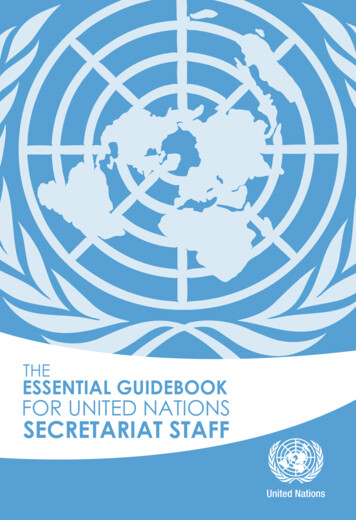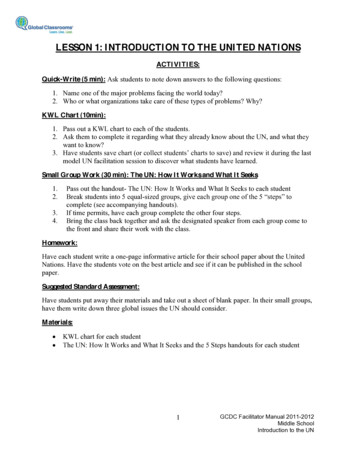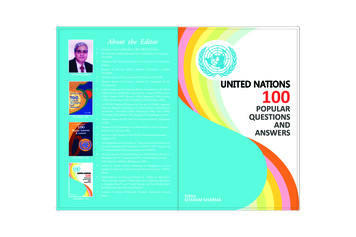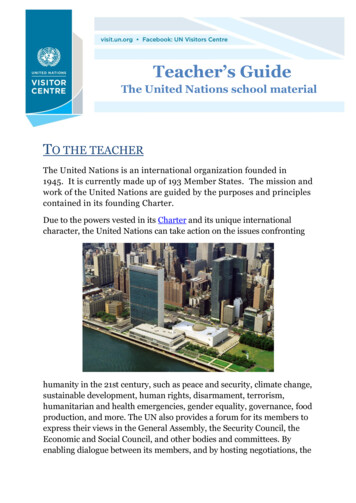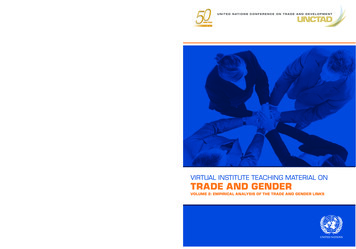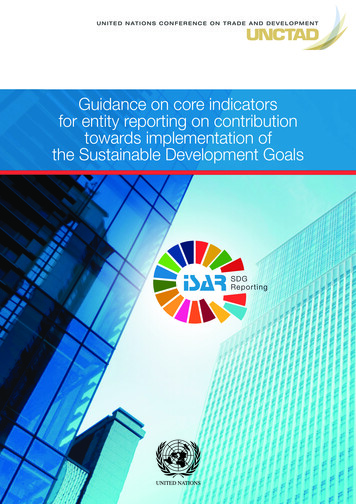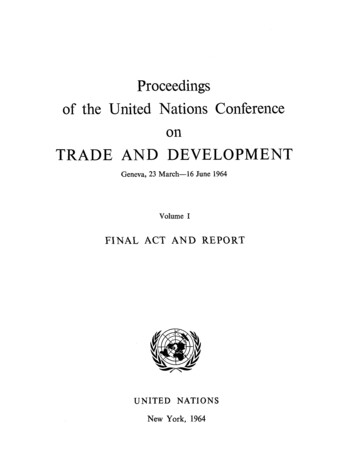
Transcription
Proceedingsof the United Nations ConferenceonTRADE AND DEVELOPMENTGeneva, 23 March—16 June 1964Volume IFINAL ACT AND REPORTUNITEDNATIONSNew York, 1964
NOTEThe designations employed and the presentation of the material in this publication do notimply the expression of any opinion whatsoever on the part of the Secretariat of the UnitedNations concerning the legal status of any country or territory or of its authorities, or concerningthe delimitation of its frontiers.***Symbols of United Nations documents are composed of capital letters combined withfigures. Mention of such a symbol indicates a reference to a United Nations document.E/CONF.46/141, Vol. IUNITED NATIONS PUBLICATIONSalesNo.:64, II.B. 11Price: SUS 3.00(or equivalent in other currencies)Copyright United Nations, 1964Manufactured in Switzerlandii
FOREWORDThe United Nations Conference on Trade and Development held in Geneva in the springof 1964 ushered in a new chapter in the history of United Nations endeavours to acceleratethe economic development of developing countries. The Conference has shown the way towardsa more just and rational international economic order in which the poor nations, which makeup the great majority of mankind, will at long last be able to have an adequate share in the fruitsof economic and technological progress.The Conference has taken the first steps towards the establishment of a new trade policyfor development. It has, moreover, recognized that if the acceptance of broad principles andpolicies for the conduct of international trade is to have real meaning, those principles and policiesmust be translated into practical action through effective international machinery.The results of the Conference are an eloquent tribute to the wisdom and maturity of itsparticipants. Despite differences of opinion on many problems, they laboured unremittinglyto achieve the greatest -possible degree of agreement on a number of urgent measures whichshould be taken by both developed and developing countries. They also decided to studyfurther a number of other measures on which agreement had not yet been reached.Publication of the Conference proceedings is intended in the first instance to furnish Governments and the General Assembly with a full account of what has been accomplished and whatremains to be done. It should also help to meet the wider public interest in questions ofdevelopment and trade which the Conference has stimulated.It is my hope that the work begun in Geneva will move forward with vigour and imagination.UTHANTSecretary-General of the United Nationsin
PREFATORY NOTEThis eight volume series attempts to provide a self-contained reference to the Proceedingsof the United Nations Conference on Trade and Development. Apart from the actual Proceedings of the Conference, and the reports of the five Main Committees, it contains most ofthe background material prepared for the Conference and other documents referred to in theProceedings. Only papers of a more limited character, such as country studies or specialcommodity studies have, for technical reasons, been excluded.The Final Act adopted by the Conference (including the thirty-five Principles and fifty-sevenRecommendations) together with the Report of the Conference are published in volume I. Thisvolume also contains a complete check list of all documents used during the Conference.The report "Towards a New Trade Policy" submitted by the Secretary-General of theConference prior to the opening of the Conference is published in volume II. This volumealso contains the opening addresses delivered by the President of the Swiss Confederation, theSecretary-General of the United Nations and the President and Secretary-General of the Conference together with the opening and closing policy statements of the heads of delegations, andrepresentatives of specialized agencies and GATT, regional economic groupings, non-governmental organizations, etc.The pre-Conference documents are published in volumes III to VII inclusive. For the sakeof convenience the material has been divided into five parts according to the agenda items forthe five Main Committees :First CommitteeSecond CommitteeThird CommitteeFourth CommitteeFifth CommitteeInternational commodity problemsTrade in manufactures and semi-manufacturesImprovement of the invisible trade of developing countries andfinancing for expansion of international tradeInstitutional arrangementsExpansion of international trade and its significance for economicdevelopment and implications of regional economic groupingsThe allocation of the papers is of necessity somewhat arbitrary since some of these applyto more than one Committee. The texts of the pre-Conference documents are here presentedin the form in which they were originally submitted to the Conference, with no editorial changesas regards references. However, where references have been made to documents bearingE/CONF.46. symbols and which have been reprinted in this series, the number of the volumein which they appear has been inserted.Volume VIII contains those documents of the Conference on Trade and Developmentwhich, it was felt, should be published for reference purposes, but which did not fall obviouslyinto any of the categories covered by the other volumes of the series. These documents consistof the reports of the three sessions of the Preparatory Committee, followed by a letter from theSecretary-General of the Conference containing a list of the questions that were brought up inpreliminary discussions on the various topics of the agenda, as had been promised at the ThirdSession of the Preparatory Committee; a number of letters and memoranda concerning someof the other issues raised during the meetings, five draft recommendations which could not bediscussed for lack of time, but which the Conference felt were of sufiicient interest to warranttheir transmission to the " continuing machinery ", the relevant extract from a booklet publishedby the FAO which is now difficult to obtain but which was frequently referred to during the Conference, memoranda from two of the non-governmental organizations and finally the list ofmembers of delegations attending the Conference, of observers sent by various organizations,and also of the secretariat of the Conference.v
The titles of the eight volumes of the series are as follows :VI Trade expansionI Final Act and Reportand regional groupingsII Policy statementsPart 1III Commodity tradeVII Trade expansionand regional groupingsIV Trade in manufacturesPart 2V Financing and invisiblesVIII Miscellaneous documentsInstitutional arrangementsand list of participantsEXPLANATORY NOTEThe following symbols have been used in the tables throughout the series :Three dots (.) in some studies or two dots (.) in others indicate that data are not available or are notseparately reportedA dash (—) indicates that the amount is nil or negligibleA blank in a table indicates that the item is not applicableA minus sign (-) indicates a deficit or decrease, except as indicatedA full stop (.) is used to indicate decimalsA comma (,) in the text and a space in the tables are used to distinguish thousands and millionsA stroke (/) indicates a crop year or financial year, e.g., 1960/61Use of a hyphen (-) between dates representing years, e.g., 1961-1963, signifies the full period involved, includingthe beginning and end years.Reference to "tons" indicates metric tons, and to "dollars" United States dollars, unless otherwise stated.The term "billion" signifies a thousand million.Annual rates of growth or change, unless otherwise stated, refer to annual compound rates.Details and percentages in tables do not necessarily add to totals, because of rounding.Certain abbreviations have been used :AID Agency for International Development (United States).OCT Commission on International Commodity Trade.CMEA Council of Mutual Economic Assistance.D AC Development Assistance Committee (of the Organisation for Economic Co-operation and Development)EDF European Development Fund (of the European Economic Community).EEC European Economic Community.EFTA European Free Trade Association.EPTA Expanded Programme of Technical Assistance (of the United Nations).FAO Food and Agriculture Organization of the United Nations.GATT General Agreement on Tariffs and Trade.IBRD International Bank for Reconstruction and Development.ICCICA Interim Co-ordinating Committee for International Commodity Arrangements.ICIO Industrial Credit and Investment Corporation of India.IDA International Development Association.IDB Inter-American Development Bank.IFC International Finance Corporation.OAS Organization of American States.OECD Organisation for Economic Co-operation and Development.OEEC Organisation for European Economic Co-operation.OPEC Organization of Petroleum Exporting Countries.SITC Standard International Trade Classification.UNICEF United Nations Children's Fund.UNRWA United Nations Relief and Works Agency for Palestine Refugees.UNSF United Nations Special Fund."Rhodesia and Nyasaland" stands for the Federation of Rhodesia and Nyasaland.The Republic of South Africa is so designated even where the material covers the period prior to 31 May 1961,when the country was known as the Union of South Africa.Where statistical presentation has rendered it necessary, "Malaya" has been used to designate the Federationof Malaya and Singapore; "South Africa", the Republic of South Africa, South West Africa and the High Commission territories of Basutoland, Bechuanaland and Swaziland; and "UAR" the United Arab Republic.VI
TABLE OF CONTENTSFINAL ACTFIRST titution and proceedingsFindingsReasons and considerationsSECOND PART.3458A CONSOLIDATION OF THE RECOMMENDATIONS OF THE CONFERENCEI. Principles10II. International commodity problemsIII. Trade in manufactures and semi-manufacturesIV. Financing for an expansion of international trade and improvement of the invisible trade of developing countriesV. Institutional arrangements1213VI. Special problemsVII. Programme of work1616THIRD PART.ANNEXESA. The Recommendations of the ConferenceA.I.IGeneral and Special PrinciplesA.I.2Principles relating to transit trade of land-locked countriesA.I.3Principles governing international trade relations and trade policies conducive to developmentA.II.lInternational commodity arrangements and removal of obstacles andexpansion of tradeA.II.2 ImplementationA.II.3 Consideration of principles and guidelinesA.II.4 Promotional measuresA.II.5 Promotion of trade between developing countriesA.II.6 World Food Aid ProgrammeA.II.7 Competition from synthetics and substitutesA.II.8 Study of organization of commodity tradeA.II.9 Minerals and fuelsA.III.l Expansion of United Nations activities in the field of industralization—Establishment of a United Nations specialized agency for industrial developmentvii13151718252626303131313232333334
8A.IV.9A.IV.10A.IV.llA.IV.12A.IV. 13A.IV. 14A.IV.15A.IV. 16A.IV. 17A.IV.18A.IV. rial branch agreements on partial division of labour between developing countries and developed countries which are interested in this formof co-operation and for which this scheme is applicableCriteria for development of industries with an export potential in developingcountriesGuidelines for tariff and non-tariff policies in respect of manufactures andsemi-manufactures from developing countriesPreferencesMeasures by the developed countries with market economies for expansionand diversification of exports of manufactures and semi-manufactures bydeveloping countriesMeasures by countries with centrally-planned economies for expansion anddiversification of exports of manufactures and semi-manufactures bydeveloping countriesMeasures and actions for the promotion of trade in manufactures and semimanufactures among developing countriesGuidelines for international financial co-operationGrowth and aidAims of international financial and technical co-operationTerms offinancingProblem of debt service in developing countriesNon-financial credit arrangements for the delivery of capital goods . . .United Nations Capital Development FundGradual transformation of the United Nations Special FundCreation of a regional development fundRegional developmentScheme for increasing capital flows to developing countries through aninterest equalization fundPromotion of private foreign investment in developing countries . . . .Needs of the public sector in the transfer of external resources to developingcountriesSuppliers' credits and credit insurance in developed and developing countriesScheme for lowering the interest cost of loans to developing countries bymeans of an interest rebate fundScheme for investigating the financing of marketing of primary productsfrom developing countriesStudy of measures related to the compensatory credit system of the International Monetary FundSupplementary financial measuresInternational monetary issuesParticipation of developing countries in the activities of the internationalfinancial and monetary institutionsShipping questionsCommon measure of understanding on shipping questionsInsurance and reinsuranceMeasures for increasing the receipts of developing countries from tourismConditions of economic and technical 484950505151525253545454555557
PageA.IV.26 Transfer of technology,A.V. 1Institutional arrangements, methods and machinery, to implement measuresrelating to the expansion of international tradeAppendix I: List of States indicated in paragraph 5 (i)Appendix II: List of States indicated in paragraph 5 (ii)Appendix III : List of States indicated in paragraph 5 (iii)Appendix IV: List of States indicated in paragraph 5 (iv)A.V.2Arrangements during interim periodA.V.3Terms of reference of subsidiary organsA.VI.1 Preparation of a convention relating to the transit trade of land-lockedcountriesA.VI.2 Trade needs of developing countries with exports mainly composed of nonrenewable natural productsA.VI.3 Long-term trade agreementsA.VI.4 Direct participation by governmental trade organizations in foreign trade.A.VI. 5 Economic and social survey of the depressed areas of the developingcountriesA.VI. 6 Continuing studies and reports on trade and developmentA.VI.7 Problems arising in trade relations between countries having differenteconomic and social systemsA.VI.8 Implications of regional economic groupingsA.VI.9 Development needs of education and scienceA.VI.IO Elaboration of trade aspects of the economic programme of disarmamentB. Observations of delegationsI. Observations and reservations submitted by groups of countriesII. Observations and reservations submitted by individual countriesIII. Index to 666983C. Other documentsI. Messages from Heads of State:Algeria, Cameroon, Ethiopia, Ghana, Guinea, India, Indonesia, Japan,Liberia, Mali, Mongolia, Morocco, Nepal, Pakistan, Peru, Philippines,Romania, Tunisia, Union of Soviet Socialist Republics, United ArabRepublic, United States of America and YugoslaviaII. Communications dated 10 June 1964 from theUnion of Soviet Socialist Republics, Czechoslovakia, Hungary and Poland8694Final Clauses9686REPORT OF THE CONFERENCESectionI. Background and constitution of the ConferenceII. Action by the Conference on the reports of the CommitteesCredentials CommitteeGeneral CommitteeFirst CommitteeSecond Committeerx101106106106106107
SectionIII.PageThird CommitteeFourth CommitteeFifth CommitteeDrafting Committee for the Final Act107109110IllAdoption of the report of the Conference112ANNEXESA.REPORT OF THE CREDENTIALS COMMITTEEB.REPORT OF THE GENERAL COMMITTEE113115(A) Final Act. Report and record of proceedings of the Conference(B) Reports of Main Committees(C) Terms of reference of the Drafting Committee for the Final Act115115116C.NOTE BY THE PRESIDENT: SIZE AND COMPOSITION OF THE DRAFTING COMMITTEE FORTHE FINAL ACT117D.REPORT OF THE FIRST COMMITTEE118International commodity problems1.Review of the long-term trends and prospects for primary commodity producers(including terms of trade) [agenda item 11 (a)]2. Programme of measures and action for the removal of obstacles (tariff, non-tariffand other) and of discriminatory practices, and for expansion of market opportunities for primary commodity exports and for increases in their consumptionand imports in developed countries [agenda item 11(e)]3. Measures for stabilization of primary commodity markets at equitable and remunerative prices including commodity arrangements [agenda item 11(d)] . . . .4. International compensatory financing and measures for stabilization of primaryexport earnings at adequate levels [agenda item 11(e)]Draft recommendations:(A) Implementation(B) Removal of obstacles and expansion of trade(C) Promotional measures(D) Competition from synthetics and substitutes(E) International commodity arrangements(F) World Food Aid Programme(G) Study of organization of commodity trade(H) Consideration of principles and guidelines5. Measures and action for promotion of trade in primary commodities among developing countries [agenda item 11(c)]Draft recommendation:(I) Promotion of trade between developing countries6. Observations of delegations on the recommendations of the CommitteeAppendix I :Effects of synthetics and substitutes on primary commodity trade : reportof the Working Party on Synthetics and SubstitutesAnnex to Appendix I. Statement by the representative of FAO made before WorkingParty 1 on 24 April 1964Appendix II : International compensatory financing and measures for stabilization ofprimary export earnings at adequate levels : Note of transmission from the First Committee to the Third CommitteeAppendix III: Principles of commodity 33136138139141
PageE.REPORT OF THE SECOND COMMITTEETrade in Manufactures and Semi-ManufacturesF.Introduction: Organization of work143The issues before the CommitteeAgenda item 12:Trade in manufactures and semi-manufactures(a) Measures and action for diversification and expansion of the exports of manufactures and semi-manufactures by developing countries with a view to increasingtheir share in world trade;143145(b) Measures for the expansion of markets of the developed countries for exportsof manufactures and semi-manufactures of developing countries ;(i)Programme of measures and action for the progressive reduction andelimination of tariffs on imports of manufactures and semi-manufactures ;(ii)Programme of measures and actions for the progressive reduction andelimination of quantitative and other restrictions and discriminatorypractices to imports of manufactures and semi-manufactures;(iii) Programme of measures and actions for the expansion of market opportunities for exports of manufactures and semi-manufactures produced indeveloping countries and for increases in their consumption and imports .151(c) Measures and actions for promotion of trade in manufactures and semi-manufactures among the developing countries160Appendix I.162Synoptic record of proposalsAppendix II. Text of proposal referred to in paragraph 36 of the report of the secondcommittee166Appendix III. List of documents before the committee166REPORT OF THE THIRD COMMITTEEInternational commodity problems:International compensatory financing and measures for stabilization of primaryexport earnings at adequate levelsImprovement of the invisible trade of developing countries financing for an expansionof international tradeChapter I.General introduction169Chapter II.Summary of the general debate1. Brief summary of the debate2. Proposals and suggestions made during the debate170170171Chapter III.Consideration of proposals1. Proposals related to financing for an expansion of international trade . . .A. Economic growth and foreign exchange resourcesB. Principles for the external financing of economic development176176176180C Measures to increase the flow of external finance and measures regardingmultilateral assistanceD. Measures to ease the burden of external debt2. Proposals related to compensatory financing and supplementary financialmeasuresxi185194200
PageF.REPORT OF THE THIRD COMMITTEE(continued)3. Proposals related to the invisible trade of developing countriesA. Shipping questionsB. Tourism and travelC. Insurance and reinsuranceD. Transfer of technologyChapter IV.Summary and conclusionsAppendix I. Texts of draft recommendations approved by the Committee . . . .Appendix II. Report of the Working Party on ShippingG.203204205206207208219REPORT OF THE FOURTH COMMITTEEInstitutional arrangements, methods and machineryto implement measures relating to the expansion of international tradeOrganization of workPreamble:Consideration of proposalsProposals on institutional questions transmitted by other CommitteesArrangements during the interim periodAppendix I. Recommendations adopted by the Fourth CommitteeAppendix II. First comparison of the draft recommendations formally submittedto the Fourth Committee :Comparative text of draft recommendations submitted to the FourthCommitteeAppendix III. Second comparison of the draft recommendations formally submittedto the Fourth CommitteeAppendix IV. Proposals on Institutional arrangementsH.203REPORT OF THE FIFTH COMMITTEE230231233240240240243244268288294Appendix I.Report of the Sub-Committee on Land-locked Countries to the FifthCommitteeAppendix II. Report of the Working Group established by the Fifth Committeeto prepare draft principles on agenda item 10 (e)Sub-appendix to Appendix II :List of the main documents before the Working GroupAppendix III. Particular observations submitted by delegations317318320329I.CHECK LIST OF DOCUMENTS OF THE CONFERENCE AND THE PREPARATORY COMMITTEE .331J.RULES OF PROCEDURE OF THE CONFERENCE363Contents of the eight volumes of the seriesxii369
Final ActAdopted by the Conferenceat its thirty-fifth plenary meeting held on 15 June 1964
FINAL ACTFIRST PART—PREAMBLEThe United Nations Conference on Trade and Development has adopted this Final Act.The extensive development of equitable and mutuallyadvantageous international trade creates a goodbasis for the establishment of neighbourly relationsbetween States, helps to strengthen peace and anatmosphere of mutual confidence and understandingamong nations, and promotes higher living standardsand more rapid economic progress in all countries ofthe world. Finally, the accelerated economic development of the developing countries depends largely on asubstantial increase in their share in internationaltrade.4. The task of development, which implies acomplex of structural changes in the economic andsocial environment in which men live, is for the benefitof the people as a whole. The developing countriesare already engaged in a determined attempt toachieve, by their own efforts, a breakthrough intoself-sustaining economic growth which furthers socialprogress. These efforts must continue and be enlarged.Economic and social progress should go together.If privilege, extremes of wealth and poverty, and socialinjustice persist, then the goal of development is lost.If the social and cultural dimension of development isignored, economic advance alone can bring no abidingbenefit.5. The developing countries recognize that theyhave the primary responsibility to raise the livingstandards of their peoples ; but their national exertionsto this end will be greatly impaired if not supplementedand strengthened by constructive international actionbased on respect for national sovereignty. An essentialelement of such action is that international policiesin the field of trade and development should resultin a modified international division of labour, whichis more rational and equitable and is accompanied bythe necessary adjustments in world production andtrade. The resultant increase in productivity andpurchasing power of the developing countries willcontribute to the economic growth of the industrializedcountries as well, and thus become a means to worldwide prosperity.6. The issues before the Conference have been atonce challenging and urgent. While there are varyingdegrees of development, the joint income of the developing countries, with two-thirds of the world'spopulation, is not much more than one-tenth ofthat of the industrialized countries. Moreover, theSection IBACKGROUND1. The States participating in the Conference aredetermined to achieve the high purposes embodiedin the United Nations Charter "to promote socialprogress and better standards of life in larger freedom" 1 ; to seek a better and more effective system ofinternational economic co-operation, whereby thedivision of the world into areas of poverty and plentymay be banished and prosperity achieved by all;and to find ways by which the human and materialresources of the world may be harnessed for the abolition of poverty everywhere. In an age when scientificprogress has put unprecedented abundance withinman's reach, it is essential that the flows of worldtrade should help to eliminate the wide economicdisparities among nations. The international community must combine its efforts to ensure that allcountries—regardless of size, of wealth, of economicand social system—enjoy the benefits of internationaltrade for their economic development and socialprogress.2. Recognizing that universal peace and prosperityare closely linked and that the economic growth of thedeveloping countries will also contribute to the economic growth of the developed countries, realizingthe dangers of a widening gulf in living standardsbetween peoples, and convinced of the benefits ofinternational co-operation with a view to helping thedeveloping countries to reach a higher standard oflife, the States signatories of this Final Act are resolved,in a sense of human solidarity, "to employ international machinery for the promotion of the economicand social advancement of all peoples".13. In endorsing the decision to convene the UnitedNations Conference on Trade and Development, theGeneral Assembly of the United Nations was motivated by certain basic considerations. Economic andsocial progress throughout the world depends in largemeasure on a steady expansion in international trade.1Preamble to the Charter of the United Nations.3
4FINAL ACTdramatic increase in the population of the developingcountries multiplies the difficulties they face in assuringto their peoples even the simplest elements of a decenthuman life. The aim must be to create, jointly, newtrade and new wealth, so as to share a commonprosperity, and thereby avoid the waste and otherunfavourable consequences of closed paths to development. The international community is called uponto join in a constructive and universal policy of cooperation for trade and development which will furthereconomic progress throughout the world.7. The designation of the nineteen-sixties as theUnited Nations Development Decade was a recognitionof deep world-wide concern with the urgent necessityof raising the standard of living of the developingcountries and an earnest of the resolve of the UnitedNations, working together, to accomplish this task.Wide concern has been expressed regarding theinadequacy of the Decade's objective of a minimum rate of growth of aggregate national income of5 per cent per annum by 1970. To attain even thisrate of growth it is essential that measures and actionbe taken by both the developing and the developedcountries, including measures to raise the level andaccelerate the rate of growth of earnings of the developing countries from trade, as a means of helpingthem to overcome their persistent external imbalance.8. The United Nations Conference on Trade andDevelopment was convened in order to provide, bymeans of international co-operation, appropriatesolutions to the problems of world trade in the interestof all peoples and particularly to the urgent tradeand development problems of the developing countries.In a period when their need for imports of development goods and for technical knowledge has beenincreasing, developing countries have been faced witha situation in which their export earnings and capacityto import goods and services have been inadequate.The growth in import requirements has not beenmatched by a commensurate expansion in exportearnings. The resultant trade gap, which gold andforeign exchange reserves have been inadequateto bridge, has had to be filled very largely by capitalimports. This, in itself, cannot provide a complete orpermanent solution, and indeed, the servicing ofexternal debts and the outgoings on other "invisible"items themselves present severe burdens for developing countries. Moreover, the terms of trade haveoperated to the disadvantage of the developing countries. In recent years many developing countries havebeen faced with declining prices for their exports ofprimary commodities, at a time when prices of theirimports of manufactured goods, particularly capitalequipment, have increased. This, together with theheavy dependence of individual developing countrieson primary commodity exports has reduced theircapacity to import. Unless these and other unfavourable trends are changed in the near future, the effortsof the developing countries to develop, diversifyand industrialize their economies will be seriouslyhampered.9. Deeply conscious of the urgency of the problemswith which the Conference has dealt, the States participating in this Conference, taking note of the recommendations of the Conference, are determined to dotheir utmost to lay the foundations of a better worldeconomic order.Section IICONSTITUTION AND PROCEEDINGS10. When, in the third week of December 1961,the General Assembly of the United Nations designated the current decade as "the Unite
A.IV.5 Problem of debt service in developing countries 46 A.IV.6 Non-financial credit arrangements for the delivery of capital goods . 46 A.IV.7 United Nations Capital Development Fund 47 A.IV.8 Gradual transformation of the United Nations Special Fund 47 A.IV.9 Creation of a regional development fund 48 A.IV.10 Regional development 48


